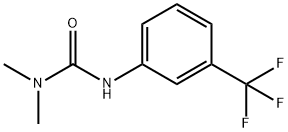| Identification | More | [Name]
Fluometuron | [CAS]
2164-17-2 | [Synonyms]
1,1-DIMETHYL-3-(1,1,1-TRIFLUORO-M-TOLYL) UREA
1,1-DIMETHYL-3-(3-TRIFLUOROMETHYLPHENYL)UREA
1,1-DIMETHYL-3-(A,A,A-TRIFLUORO-M-TOLYL) UREA
CIBA 2059(R)
COTOGARD
COTORAN
COTORAN(R)
COTTONEX
FLUOMETHURON
FLUOMETURON
Lanex
METURON
n,n-dimethyl-n'-[3-(trifluoromethyl)phenyl]urea
1,1-Dimethyl-3-(,,-trifluorl-m-tolyl)urea
1,1-Dimethyl-3-(alpha,alpha,alpha-trifluoro-m-tolyl) urea
1,1-dimethyl-3-(alpha,alpha,alpha-trifluoro-m-tolyl)-ure
1,1-dimethyl-3-(alpha,alpha,alpha-trifluoro-m-tolyl)urea
3-(3-Trifluoromethylphenyl)-1,1-dimethylurea
3-(3-Trifluoromethylphenyl)-1,1-dimethylureaopionate
3-(5-Trifluormethylphenyl)-1,1-dimethylharnstoff | [EINECS(EC#)]
218-500-4 | [Molecular Formula]
C10H11F3N2O | [MDL Number]
MFCD00018012 | [Molecular Weight]
232.2 | [MOL File]
2164-17-2.mol |
| Safety Data | Back Directory | [Hazard Codes ]
Xn | [Risk Statements ]
R22:Harmful if swallowed. | [RIDADR ]
UN2767 (Phenyl urea pesti-
cides, solid, toxic) | [WGK Germany ]
3 | [RTECS ]
YT1575000 | [HS Code ]
2924.21.0800 | [Safety Profile]
Moderately toxic by
ingestion and intraperitoneal routes.
Questionable carcinogen with experimental
carcinogenic data. Mutation data reported.
When heated to decomposition it emits very
toxic fumes of Fand NOx | [Hazardous Substances Data]
2164-17-2(Hazardous Substances Data) | [Toxicity]
LD50 in rats (mg/kg): 8900 orally; in rabbits (mg/kg): >10,000 dermally (Ben-Dyke) |
| Hazard Information | Back Directory | [General Description]
White crystals or powder. Melting point 163-164°C. Readily soluble in organic solvents. Used for pre-and post-emergence weed control in cotton. | [Reactivity Profile]
FLUOMETURON is a trifluoromethyl urea derivative. May react with hypochlorites to form nitrogen trichloride which explodes spontaneously in air [J. Am. Chem. Soc. 63:3530-32]. May reacts with azo and diazo compounds to generate toxic gases. Reacts with strong reducing agents to form flammable gases. | [Hazard]
Toxic by ingestion. Questionable carcinogen. | [Health Hazard]
SYMPTOMS: Symptoms of exposure to this chemical may include possible convulsions or coma; irritation to the skin, gastrointestinal tract, respiratory tract; and lowered blood pressure. | [Potential Exposure]
This material is used as a herbicide. | [Fire Hazard]
Flash point data are not available for this material, but FLUOMETURON is probably combustible. | [First aid]
Skin Contact: Flood all areas of body that
have contacted the substance with water. Don’t wait to
remove contaminated clothing; do it under the water stream.
Use soap to help assure removal. Isolate contaminated cloth ing when removed to prevent contact by others. Eye
Contact: Remove any contact lenses at once. Flush eyes
well with copious quantities of water or normal saline for at
least 20 30 minutes. Seek medical attention. Inhalation:
Leave contaminated area immediately; breathe fresh air.
Proper respiratory protection must be supplied to any res cuers. If coughing, difficult breathing or any other symptoms
develop, seek medical attention at once, even if symptoms
develop many hours after exposure. Ingestion: Consult a
physician, hospital or poison center at once. If the victim is
unconscious or convulsing, do not induce vomiting or give
anything by mouth. Assure that the airway is open, lay on side and keep head lower than body and transport immedi ately to medical facility. If conscious and not convulsing,
give a glass of water to dilute the substance. Do not induce
vomiting without a physician’s advice. | [Shipping]
UN2767 Phenyl urea pesticides, solid, toxic,
Hazard Class: 6.1; Labels: 6.1-Poisonous materials. | [Incompatibilities]
Liquid solutions are incompatible with
oxidizers (chlorates, nitrates, peroxides, permanganates,
perchlorates, chlorine, bromine, fluorine, etc.); contact may
cause fires or explosions. Keep away from alkaline materi als, strong bases, strong acids, oxoacids, epoxides. | [Description]
Fluometuron is a white crystalline solid oftenused in liquid solution that may be flammable. Molecularweight=232.23; Freezing/Melting point=163-165C;Vapor pressure=9.4 3 1027 mmHg at 20C. HazardIdentification (based on NFPA-704 M Rating System):Health 1, Flammability 1, Reactivity 0. Slightly soluble inwater. | [Chemical Properties]
Crystalline solid. Partially
soluble in water; soluble in alcohol and acetone. | [Chemical Properties]
Fluometuron is a white crystalline solid
often used in liquid solution that may be flammable. | [Uses]
Fluometuron is an phenylurea based herbicide used on cotton and sugarcane crops. | [Uses]
Herbicide used to control many annual broad-leaved weeds in sugarcane and cotton | [Uses]
Herbicide. | [Definition]
ChEBI: Fluometuron is a member of the class of 3-(3,4-substituted-phenyl)-1,1-dimethylureas that is urea in which one of the nitrogens is substituted by a 3-(trifluoromethyl)phenyl group while the other is substituted by two methyl groups. It is a herbicide used for the control of broadleaf weeds and annual grasses in cotton. It has a role as an agrochemical, an environmental contaminant, a herbicide, a xenobiotic and a photosystem-II inhibitor. It is a 3-(3,4-substituted-phenyl)-1,1-dimethylurea and a member of (trifluoromethyl)benzenes. | [Flammability and Explosibility]
Nonflammable | [Agricultural Uses]
Herbicide: A General Use Pesticide (GUP). Fluometuron is
a selective herbicide which acts on susceptible plants by
inhibiting photosynthesis. Fluometuron is registered by
EPA exclusively for use on cotton and sugarcane. It can
be applied pre-emergence, for weed control before planting, or post-emergence, after target crops and weeds come
up, and may have residual activity for several months.
Fluometuron is available in liquid, dry flowable, and wettable powder formulations. | [Trade name]
C 2059®; CIBA 2059®; COTORAN®;
COTORAN® 50SC; COTORAN MULTI 50WP®;
COTOREX®; COTTONEX®; COTTONEX® 50SC;
DREXEL CROAK®; FLO-MET®; FLUOMETURON®
50SC; HERBICIDE C-2059®; HIGALCOTON®;
LANEX®[C]; METURON 80 DF®; PAKHTARAN®;
SETRE FLUOMETURON 80 WP® | [Environmental Fate]
Soil. In soils, ?uometuron rapidly degrades (half-life approximately 30 days) to carbon dioxide, polar and nonextractable compounds (Hartley and Kidd, 1987; Humburg et al., 1989).
Groundwater. According to the U.S. EPA (1986) ?uometuron has a high potential to leach to groundwater
Plant. In plants, ?uometuron degrades to a demethylated intermediate which subsequently is degraded to the aniline moiety (possibly m-tri?uoromethylaniline) (Hartley and Kidd, 1987; Humburg et al., 1989). Duke et al. (1991) reported that ?uometur
Chemical/Physical. Emits toxic fumes of nitrogen oxides and ?uorine when heated to decomposition (Sax and Lewis, 1987).
| [storage]
Color Code—Blue: Health Hazard/Poison: Storein a secure poison location. Prior to working with thischemical you should be trained on its proper handling andstorage. Store in a refrigerator or a cool, dry place and protect from exposure to ultraviolet light. Keep liquid awayfrom oxidizers. Where possible, automatically pump liquidfrom drums or other storage containers to processcontainers. |
|
|





